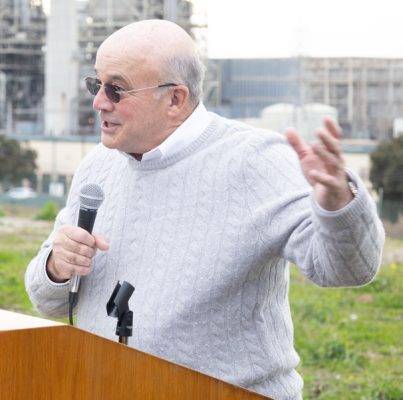
Lessons learned from the Refugio oil spill which washed up on South Bay beaches in May and possible next steps to prevent another such occurrence were discussed at a State Senate hearing at the Manhattan Beach Library on Tuesday.
“California suffered its worst oil spill in 25 years,” said State Senator Ben Allen, who represents much of coastal Los Angeles county. “I’m concerned something like this never happens again and if it does, that we respond in the best way possible.”
The meeting of the Select Committee on the Refugio Oil Spill on the spill’s impacts on the South Bay was held by State Senator Hannah-Beth Jackson, who represents the area where the spill occurred, and Allen. A crowd of about 50 people attended, including representatives of the public agencies involved with the cleanup, some environmental nonprofits, members of the Manhattan Beach and Hermosa Beach city councils and members of the public.
One recurring theme at the meeting was the need for better communication among federal and state agencies and with the general public.
Stefanie Sekich-Quinn, the preservation manager at the Surfrider Foundation, showed a map that she said a UC professor had created within a couple days of the original spill that showed the oil would go around the Channel Islands and then arrive in the South Bay. The professor tried to share his information with the National Oceanographic and Atmospheric Association (NOAA), but the organization wasn’t responsive, she said.
“I’m extremely disheartened that it was not used because we could have got a hold of the tar before it got here,” she said.
Tom Cullen from the Department of Fish and Wildlife’s Office of Spill Prevention and Response said that NOAA needed to improve its method since the organization initially said that the tar balls probably hadn’t come from the spill. The department relied on NOAA to determine if it was possible that they had.
“At first we were scratching our heads because the models used by NOAA didn’t show that it could make it down,” said Cullen. “Other models on the commercial side said, ‘It’s no surprise.’ We need to look at a different method that could be better used to predict where the plume could go.”
The misinformation, however, didn’t slow down the department’s response, Cullen said.
Manhattan Beach City Councilman Wayne Powell, who was mayor during the spill, implored the state representatives to do everything in their power to prevent a similar event.
“If it takes new legislation, enforcing existing legislation, substantial fines or all of the above, we need something to ensure this never happens again,” said Powell. “If another oil company sees that it’s going to hit their pocket book, or there may be criminal charges, maybe things will change.”
Jackson stressed that the attorney general was conducting a criminal investigation into the spill, which originated from a pipeline owned by Plains All American Pipeline, and that civil lawsuits had been filed.
“This is going to a have a profound economic impact” on the company, she said.
Jackson also briefly mentioned three bills passed in response to the spill which Governor Jerry Brown signed in October.
They include Senate Bill 295, which requires annual pipeline inspection by the State Fire Marshal; Assembly Bill 864, which requires oil companies to use the best available technology, such as automatic shutoff valves, to prevent spills; and Senate Bill 414, which discourages the use of dispersants in cleanups and requires Cullen’s office to study the best available technology for cleanups, among other things.

Senator Allen asked if the spill’s impact on the local economy and resources would be taken into account.
Cullen said that the federal and state agencies involved with the response were completing a Natural Resource Damage Assessment, a legal process which analyzes a spill’s impact on the environment and public resources and the cost to remedy it.
An expert on the process, Megan Herzog from the Emmett Institute on Climate Change and the Environment at UCLA, said that the people conducting the study might talk to businesses affected by beach closures or look at the number of beachgoers compared to the past. Restoration projects could include new facilities for public access, educational centers or repairs to marinas and piers.
The assessment was used in the Deepwater Horizon settlement, according to Cullen. A final restoration plan is expected to be completed by early 2017, according to a handout provided at the meeting.
Other ideas Cullen mentioned for future consideration were creating a database of volunteers and documenting a standard level of naturally occurring tar for all of the state’s beaches.
To determine when it would be safe to open the South Bay beaches, which were closed for about two days, the government agencies set a goal of removing tar until only one percent was left. Michael Jordan of the county’s Department of Public Health said they talked to locals and lifeguards to get a sense of what was normal.
Senator Allen and a member of the public seemed incredulous that the state didn’t have a baseline for the amount of tar which naturally washes ashore.
“The criterion for opening and closing the beaches seemed anecdotal for a beach so widely used and connected to the county,” said Allen. “Are you really asking local folks?”
Leaders from Heal the Bay and the Surfrider Foundation expressed frustration that the government didn’t take advantage of their brain and muscle power.
“State and federal agencies have an incredible resource at their disposal among our members,” said Graham Hamilton, the chair of the West Los Angeles/Malibu chapter of the Surfrider Foundation.
They also lamented that they didn’t get more information to pass along.
“People were afraid to go after the beaches reopened because the information was so spotty and tar was still washing up,” said Craig Cadwallader, the head of the South Bay chapter of the Surfrider Foundation. “People come to rely on Surfrider and Heal the Bay to help make sure it’s safe. They were angry at us because we didn’t have information.”
After hearing from everyone, the senators closed the meeting.
“I think we all have a level of frustration,” said Jackson. “We learn from past mistakes.” ER










